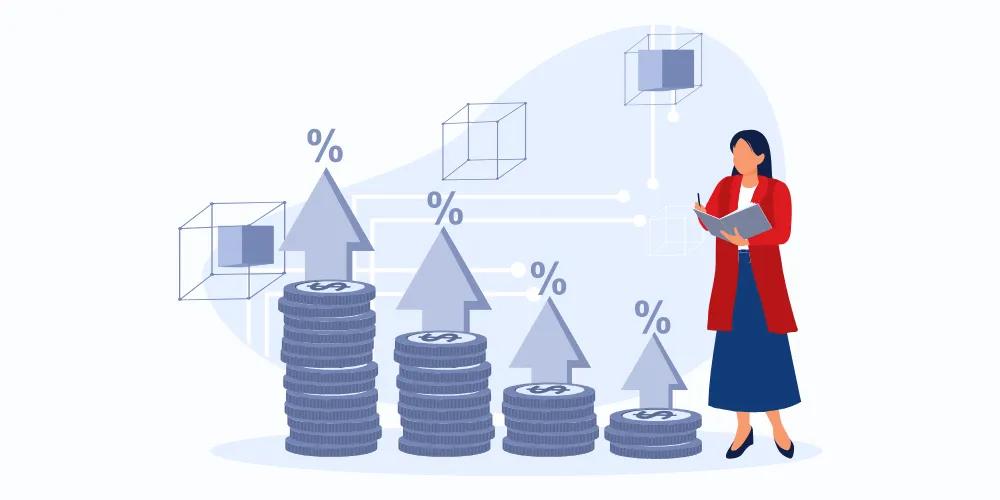Sales incentive plans vary by role based on goals and responsibilities. A field sales rep may have volume-based incentives, while an account manager might be rewarded for renewals or upselling. Tailoring plans ensures alignment with role-specific outcomes, driving more focused and meaningful performance.
Sales Incentive Plan Design: Principles & Best Practices
- Amit Jain
- Dec 01, 2020
- 4 min read
- Last updated on May 21, 2025
Introduction
Apart from all other benefits, an incentive improves your sales team's enthusiasm and energy more quickly and consistently than anything else. An effective sales incentive structure helps firms produce targeted results and lets you pay people accountable for those accomplishments. It must be straightforward and intuitive to put into action. The expectations of the sales force should be well communicated. Before constructing the strategy, agreeing on and following fundamental guiding concepts is critical. A Sales Incentive Structure's principal goal is to incentivize salespeople to accomplish defined goals directly impacting the company's bottom line. A sales incentive plan design varies per company and often depends on team structure, resources, and objectives.
The Role of Data in Sales Incentive Plan Design
Data is crucial in designing an effective sales incentive plan, ensuring incentives are fair, motivating, and aligned with business objectives. Companies can set realistic quotas and commission structures by analyzing historical performance, sales trends, and market benchmarks. Predictive analytics helps refine targets, identify top performers, and adjust rewards based on evolving market conditions. Additionally, real-time tracking of key sales metrics allows businesses to make data-driven adjustments, preventing overpayment or undercompensation. Without data-driven insights, incentive plans risk being ineffective, demotivating, or misaligned with revenue goals. Leveraging data-backed sales incentive structures ensures transparency, accuracy, and continuous optimization for long-term gain.
Effective Strategies for Sales Incentive Plans
Clear communication is essential for a successful sales incentive plan design, as misunderstandings can lead to disputes and disengagement. To ensure transparency, businesses should use multiple communication tools, including interactive dashboards, regular training sessions, and detailed documentation. Real-time tracking tools help sales teams understand their progress and earnings potential, while one-on-one coaching sessions reinforce incentive structures. Additionally, companies should provide a centralized document repository with FAQs, payout schedules, and plan details to avoid confusion. Effective sales incentive structure communication boosts trust, motivation, and performance, ensuring reps fully understand and engage with their compensation plans.
A few key design principles that you need to consider:
1. Business Objectives Alignment
The design of a Sales Incentive Structure is built on the foundation of goals. A good sales incentive structure should be connected with the company's goals, be easily comprehended and explained, and provide salespeople and managers with specific targets to strive toward. You must thoroughly understand the company's overall business, brand, and channel strategies and the sales commission plan's ability to achieve those goals through relevant performance indicators. Whatever strategy an employer employs, the objectives must be clear, realistic, and quantifiable. Although most firms base their objectives in part on revenue or profitability, it is preferable to take a more detailed or precise approach when defining goals. The strategy should encourage salespeople to target the appropriate customer segment.
2. Pay for Performance
The sales Incentive Structure should be intended to reward salespeople for better company results and performance. Paying workers according to corporate values also demonstrates the good behaviors you want them to display. Salespeople should be compensated not just for their effort but also for their real influence on sales success and growth. Pay for performance links employees' pay with their efforts at work, encouraging them to create more to earn more. Employees realize they have a higher chance of improving their assessments by hitting specified objectives, even though this approach still relies on performance reviews. Better performers should be paid more than lower performers at a high level. A general consensus is that the top performers should be paid disproportionately more. Performance goals should not be set so high that they are impossible to meet. Likewise, they should not be set so low that meeting them is a certain assumption.
3. Equal Earning Opportunity
The Sales Incentive Structure is considered fair when it provides equal earning opportunities to all salespeople irrespective of their territory size, geographical location, or book of accounts. The sales Incentive Structure should ensure that localized challenges are accounted for, removing any biases that may work against an individual salesperson.
4. Financially Responsible
The total incentive payout for the entire salesforce should align with the national performance. A well-designed sales incentive structure should pay for itself and allow sharing failures and successes with the sales force.
5. Competitive in the Labor Market
An organization may effectively set compensation ranges for each position and specify the goal, commissions, bonuses, and other incentives needed to maintain sales operations competitively using market data. The components of the Sales Incentive Structure and overall target pay should be established to attract the best salespeople in the market and allow top performers to stay with the company. One of the biggest reasons for sales attrition is out-of-sync variable compensation plans and non-competitive sales incentives. Offering an attractive Sales Incentive Structure guarantees that the company can hire and retain excellent salespeople.
6. Simple to Understand and Administer
The main objective is to develop a Sales Incentive Structure that sales teams can understand. Salesforce's ability to comprehend the sales commission scheme is crucial to its success. How you explain and carry out the strategy is, without a doubt, the most critical factor. After you've put your strategy in place, keep an eye on it to see whether you need to make any revisions in the middle of the year. It should be simple for salespeople to comprehend and implement without requiring manual involvement. Automated systems for obtaining data and monitoring the performance of your Sales Incentive Structure can be quite beneficial.
7. What-if Scenarios
What-if planning is about making better decisions and lowering possible risk, benefiting the bottom line. It helps managers confidently make the correct decision at the appropriate moment. Because various departments and divisions have different demands, it's a good idea to create a few alternative Sales Incentive Structures and test them against what-if scenarios to verify the plan fits the organization's business needs. It's critical to figure out how different levels of sales results would affect the total commission budget.
Sales operations may develop the most successful structures by modeling some plan adjustments, such as commission rates, thresholds, accelerators, and performance distribution. Risk identification can aid in reducing cost overruns, forecasting bias, and other erroneous predictions that can distort reporting and budgeting. Managers may make choices based on real-time information if they can plan for anticipated challenges, which reduces mistakes that damage the company's bottom line. What-if scenarios can be performed in minutes, not weeks or months, for firms that need to make changes on the go.
Payout Mechanics and Frequency
Sales incentive plan design and timing significantly impact sales behavior and motivation. Frequent payouts—such as monthly or bi-weekly commissions—keep sales reps engaged, reinforcing the connection between effort and reward. Quarterly or annual payouts, while effective for long sales cycles, require clear expectations to maintain motivation.
Different payout mechanisms influence performance in distinct ways:
1) Commission-based payouts directly reward each sale, driving short-term performance.
2) Quota-based payouts incentivize hitting specific revenue or unit targets, fostering consistency.
3) Installment payments, often used in subscription or long-term contract sales, ensure retention and reduce churn by aligning payouts with customer commitments.
Sales cycle length should dictate payout structure. For short sales cycles, such as transactional B2C sales or low-value SaaS deals, immediate commission payouts (weekly or monthly) work best. This ensures quick rewards that drive high-volume sales and sustained motivation.
In contrast, long sales cycles, like enterprise software or large B2B deals, require structured payouts to maintain engagement. Companies often use milestone-based payouts, distributing commissions at key stages such as contract signing, implementation, and retention, or opt for installment payments, spreading earnings over 6–12 months to align with recurring revenue models. In subscription-based models, commissions are frequently tied to customer retention, offering bonuses for renewals or multi-year contracts. This approach incentivizes sales teams to prioritize long-term value over quick wins, ensuring sustainable growth and customer success.
Common Challenges in Plan Design
Creating an effective sales incentive plan design has several challenges that can impact motivation and business growth. Key pitfalls include:
Misalignment with Business Goals – Incentives should drive long-term growth, not just short-term wins. A well-structured sales incentive plan design aligns rewards with revenue targets, customer retention, and profitability.
Complexity - Overly intricate sales incentive plan designs can confuse sales teams, making it harder to track performance. Keeping the plan clear and transparent ensures sales reps understand their earning potential.
One-Size-Fits-All Approach – Different sales roles require tailored sales incentive plan designs. Field sales reps, inside sales teams, and account managers should receive distinct incentives based on their responsibilities and impact.
Lack of Flexibility – A rigid sales incentive plan design may not adapt to market changes, leading to disengagement. Plans should allow for adjustments based on evolving sales strategies and business needs.
To prevent confusion and demotivation, a well-defined sales incentive plan design should be clear, adaptable, and aligned with company objectives, ensuring fairness and driving sustained sales performance.
5 Practices for Creating a Successful Incentive Plan
A group of ants collaborates; workers and minions do the grunt work necessary to keep things running smoothly. They accomplish everything, like gathering food or building an ant hill for their living. Ants do not need a leader because they know their tasks and responsibilities.
Their motivation? - Survival.
On the other hand, a sales team requires a team leader to keep them pushing. However, motivating sales representatives is a difficult task. You must have an incentive plan to incentivize sales representatives to maintain a steady revenue flow in the business.
Numbers back this up: Organizations that use a sales incentive plan claim a 79% success rate in meeting their goals by delivering the appropriate reward.
Suppose the teams sense that they are appreciated in addition to their job. In that case, they are more likely to channel that same energy and commitment of time into creating client connections, which may encourage organizational growth.
A proper incentive strategy is required to achieve a decent result from the sales force.
According to the Incentive Research Foundation, 90% of the top-performing organizations use some sales incentive plan. According to reports, a well-structured incentive plan may boost employee performance.
As said, investment in employees is an investment in the organization.
Incentive motivates them to accelerate and grow alongside the organization. When management recognizes their reps' efforts, it gives them a sense of security and support from the organization.
Therefore, you must implement an incentive plan to boost your sales reps. Here are some incentives to consider while planning a successful incentive plan.
1. Role-specific Incentives
Reminding your sales reps about their performance boosts their confidence and increases their desire to work. However, every sales rep from different roles must get incentives based on their roles. A role-specific incentive, on the other hand, will recognize their worth and significance to the company.
For example, an organization may have employees with varied roles, such as a product manager overseeing the product and a sales manager supervising the sales strategies and managing the sales team. Sales representatives, on the other hand, sell the product. Employees’ targets change based on their roles and responsibilities, and incentives are compensated fairly.
2. Provide Personal SPIFF
SPIFF is a bonus given to a sales representative immediately after meeting a specific goal. It is also known as a Sales Performance Management Incentive. Providing SPIFF can increase a sales rep’s trust in the organization. SPIFFs are a kind of incentive that is always offered on the spot. It is a spontaneous as well as a short-term incentive. 92% of employees say they’re more likely to repeat an action when recognized for it. SPIFF is an incentive fund presented to a sales rep for achieving anything specific. However, before implementing SPIFF, ensure you have a budget and plan. SPIFF providers must have a proper incentive system that is clearly explained among all sales representatives.
3. Split Incentive
Companies provide incentives based on the performance of their sales representatives. The more goals you meet, the more incentive you will receive. However, there is also a specific incentive structure. A sales representative must sell a product or service, but what if the product or service is too complex to sell? Well, he/she would undoubtedly require assistance, which is where the concept of split incentive comes into play, in which a sales rep hires a sales specialist to sell the product/service. They then sell the product/service as a group and have their incentives divided according to the incentive plan.
A product company, for example, introduces a new product and continues to add features to it, which makes it more difficult for the sales rep to sell. As a result, a sales specialist collaborates with the sales rep to sell the product. Their incentive is also split in this manner.
4. Pre-sales Incentives
The world has evolved to where people only buy products/services after comparing them to other options. Many options are available; choosing the best one requires careful comparison and research.
To compete in the market, the sales team requires a sales incentive plan that doubles their energy and meets their needs. Did you know? 56% of employees think their employer should understand them, and they’re expected to understand customers, but only 39% felt their workplaces fulfilled this expectation.
However, pre-sales incentives motivate sales representatives and make them feel trusted. This can be advantageous for the organization's short and long-term objectives.
5. Setting up the Right Inflection Points
Incentive plans usually align with organizational goals and have a long-term (1-year) focus. However, it may be possible to miss out on tactically motivating the salesperson on the field daily. One way to overcome this is to set up the plan in a way that keeps pushing your sales team day in and day out. The key to it is identifying and setting up the right inflection points.
For instance, the 70% threshold (first inflection point) pushes your sales rep to earn at least some incentive (say 50% of the target pay). He tries hard and achieves it, and gets further excited when he gets 100% pay upon achieving 100% of his target. Another 30% of achievement yields 50% of additional pay. Why would he not put in that extra effort? Imagine continuing and giving him 125% pay at 120% achievement and 200% at 150% achievement. At every inflection point, you are building excitement, which continues month after month.
Takeaway
Motivation is an art rather than a science. Even though these tactics have been proven to work, it's worth trying to find the best Sales Incentive Structure for your team, goals, and culture. However, this is easier said than done. Balancing the above factors in an effective, cost-effective sales compensation plan is both a science and an art. There are inherent counteracting pressures between these guiding principles that require the Sales Incentive Structure designer to maintain a fine balance:
-The incentive plan needs to be simple to understand and fair.
-The sales compensation plan should motivate, attract top talent, and be fiscally responsible.
-The incentive plan is designed to be fair, but should also be easy to implement and cost-effective.
Frequently Asked Questions
How do sales incentive plans differ for different sales roles?
What is the impact of sales incentive plans on long-term employee retention?
Well-designed incentive plans boost motivation and loyalty. When rewards are consistent, fair, and achievable, they enhance job satisfaction and reduce turnover. Long-term incentives like deferred bonuses or performance-linked growth opportunities encourage employees to stay invested in the company’s success.
How should a sales incentive plan be adjusted for seasonal sales fluctuations?
Set flexible targets that align with expected demand cycles to account for seasonality. Use rolling averages, tiered goals, or season-specific KPIs to motivate reps year-round. This prevents demotivation during low seasons and maximizes performance during peak periods.
What are the best practices for communicating a sales incentive plan to the team?
Clarity is key—explain the plan simply and outline goals, timelines, and payout logic. Use visuals or dashboards for transparency. Encourage questions, offer regular updates, and ensure managers reinforce messaging. Effective communication builds trust and ensures the team is aligned and engaged.




